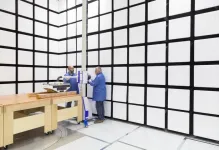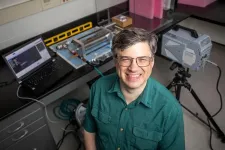(Press-News.org) Philadelphia, October 28, 2024 – CRISPR/Cas9 is a gene editing tool that has revolutionized biomedical research and led to the first FDA-approved CRISPR-based gene therapy. However, until now, the precise mechanism of exactly how this tool works and avoids creating detrimental off-target effects was not well understood. Now, using state-of-the-art technology, researchers from Children’s Hospital of Philadelphia (CHOP) have identified several specific steps needed for CRISPR to become active and perform its gene editing function. These preclinical findings could lead to improved designs for CRISPR-based gene editing. The findings were published today in the journal Cell Chemical Biology.
Gene editing allows genetic material to be added, removed or altered in some other way on a person’s genome. In healthcare, it has enormous potential to “correct” mutated genes that form the basis of many rare and complex diseases. However, for gene editing to be effective, it needs to be precise and only edit at an intended target.
While clinical trials have explored the direct delivery of Cas9 to patients through lipid nanoparticles for gene editing since 2020, broad applicability is challenging. Cas9 has the potential to perform unintended genome edits outside the target gene that could be harmful and could even turn cells cancerous. Therefore, cells taken from a patient are used to perform gene editing outside the body before delivering them back into the patient. This is an expensive and time-consuming process, driven by an incomplete understanding of gene editing mechanisms.
“We always had a suspicion that what we could see from existing structures from the gene editing process was not telling us the whole story,” said senior study author Nikolaos G. Sgourakis, PhD, Associate Professor in the Center for Computational and Genomic Medicine at CHOP and Associate Professor in the Department of Biochemistry and Biophysics at the University of Pennsylvania Perelman School of Medicine.
In this study, researchers used a technique called nuclear magnetic resonance spectroscopy to visualize atoms and proteins as well as their dynamics to observe how they move between different states. This method allowed the researchers to observe CRISPR as it transitions from an inactive to an active state and the steps required to make this happen, which was not possible without this state-of-the-art equipment.
Operating like a proofreader within an assembly line, an intermediate “surveillance” structure serves as a gatekeeper to regulate the enzyme’s DNA cutting activity. This step is key to discriminate between off- and on-target DNA sequences by the Cas9 protein that match its programmable guide RNA, a short sequence that directs DNA editing to precise locations in the genome. There are many engineered variants of Cas9, and higher fidelity variants favor the recognition of on-target DNA and help stabilize the “surveillance” complex while this happens, thereby reducing off-target effects and making sure therapy is delivered in a more precise manor.
Understanding these underlying mechanisms of how CRISPR and Cas9 operate could lead to more effective forms of gene editing technology, including the potential to deliver the therapy directly into the body, and could even improve other therapies such as CAR-T cell therapy.
“It’s much easier to deliver the pre-programmed Cas9 complex in the form of a lipid nanoparticle to directly edit target cells in the patient when we can be sure that it’s going to do its job correctly,” Sgourakis said. “For example, precise gene editing using CRISPR technology could be used to directly modify T cells in patients, and that would allow us to simplify the adaptation of CAR-Ts and other cellular therapies.”
Nuclear magnetic resonance spectroscopy for this study was performed at the Institute of Structural Biology at the University of Pennsylvania, using shared instrumentation from the Perelman School of Medicine at the University of Pennsylvania and CHOP.
This study was supported by the National Institute of Allergy and Infectious Diseases of the National Institutes of Health grant NIH R01AI143997, the NexTGen team through the Cancer Grand Challenges partnership, Cancer Research UK grant CGCAT F-2021/100002, the National Cancer Institute grant CA 278687-01, and the Mark Foundation for Cancer Research. Further funding was provided by NIH NIGMS grants R35GM125034 and 3R35GM125034-05S, NIH grant GM136859 and the Claudia Adams Barr Program for Innovative Cancer Research.
De Paula et al, “Dynamic sampling of a surveillance state enables DNA proofreading by Cas9.” Cell Chem Biol. Online October 28, 2024. DOI: 10.1016/j.chembiol.2024.10.001
About Children’s Hospital of Philadelphia:
A non-profit, charitable organization, Children’s Hospital of Philadelphia was founded in 1855 as the nation’s first pediatric hospital. Through its long-standing commitment to providing exceptional patient care, training new generations of pediatric healthcare professionals, and pioneering major research initiatives, the hospital has fostered many discoveries that have benefited children worldwide. Its pediatric research program is among the largest in the country. The institution has a well-established history of providing advanced pediatric care close to home through its CHOP Care Network, which includes more than 50 primary care practices, specialty care and surgical centers, urgent care centers, and community hospital alliances throughout Pennsylvania and New Jersey, as well as the Middleman Family Pavilion and its dedicated pediatric emergency department in King of Prussia. In addition, its unique family-centered care and public service programs have brought Children’s Hospital of Philadelphia recognition as a leading advocate for children and adolescents. For more information, visit https://www.chop.edu.
END
Children’s Hospital of Philadelphia researchers discover underlying mechanisms that make CRISPR an effective gene editing tool
Using state-of-the-art technology, researchers say understanding underlying movements and mechanisms may pave the way for more effective forms of CRISPR-based therapy
2024-10-28
ELSE PRESS RELEASES FROM THIS DATE:
Age-period-cohort analysis of cutaneous malignant melanoma incidence in the United States from 1987 to 2016
2024-10-28
Background and objectives
The prevalence and fatality rates of cutaneous malignant melanoma (CMM) have been rising, particularly among the elderly. This study analyzes CMM incidence trends in the United States elderly population from 1987 to 2016 to inform prevention and management strategies.
Methods
Using incidence data from the Surveillance, Epidemiology, and End Results database spanning 1989 to 2008, we calculated the age-adjusted standardized population incidence rates for CMM in elderly individuals. The Joinpoint ...
NCCN Cancer Center study demonstrates usability of Health Equity Report Card (HERC) tool for driving fair access to care
2024-10-28
MINNEAPOLIS, MN [October 28, 2024] — Today, the National Comprehensive Cancer Network® (NCCN®) is presenting preliminary data from a study evaluating the usability of the Health Equity Report Card (HERC) tool during the American Public Health Association (APHA) Annual Meeting and Expo.
The HERC was created by the Elevating Cancer Equity collaboration between NCCN, the American Cancer Society Cancer Action Network (ACS CAN), and the National Minority Quality Forum (NMQF) and updated by a subsequent working group. It features 19 practice evaluation and change recommendations designed to help providers and healthcare organizations identify and address disparity and bias in care ...
SwRI adds new chamber for spacecraft-related EMC, EMI testing
2024-10-28
SAN ANTONIO — October 28, 2024 —Southwest Research Institute (SwRI) has added a semi-anechoic shielded enclosure for electromagnetic compatibility and interference (EMC/EMI) testing for spacecraft. The test chamber is the next step in SwRI’s plans to create a turnkey spacecraft integration and test center within its 74,000-square-foot Space System Spacecraft and Payload Processing Facility.
The 400-square-foot EMC/EMI Chamber is semi-anechoic, or free of echo, and shielded from electromagnetic interference. It supports performance of standard emissions and susceptibility testing with an upper frequency limit of 40 gigahertz ...
Molecular profiling using next-generation sequencing of sufficient endobronchial ultrasound-guided transbronchial needle aspiration and liquid biopsy samples in patients with advanced lung cancer
2024-10-28
Background and objectives
Tumor molecular analysis using next-generation sequencing (NGS) is the standard of care for guiding lung cancer treatment. Endobronchial ultrasound-guided transbronchial needle aspiration (EBUS-TBNA) is a minimally invasive technique used to sample mediastinal lymph nodes for diagnosing and staging lung cancer. This study aimed to determine if EBUS-TBNA provided adequate tissue samples for NGS.
Methods
We evaluated EBUS-TBNA samples from adult advanced non-small cell lung cancer patients who had both ...
Case Western Reserve University awarded $2.6 million to study impact of high blood-pressure medications on chronic kidney disease patients
2024-10-28
CLEVELAND—The National Institutes of Health awarded a four-year, $2.6 million grant to researchers at Case Western Reserve University to study how high blood-pressure drugs affect patients with chronic kidney disease (CKD).
More specifically, they want to study whether such medications increase the risk of kidney and cardiovascular disease in CKD patients.
More than one in seven Americans suffer from CKD, according to the U.S. Centers for Disease Control and Prevention (CDC). CKD is a condition where ...
Dramatic drop in marijuana use among U.S. youth over a decade: (2011 to 2021)
2024-10-28
Marijuana has emerged as one of the most commonly used illicit substances among adolescents in the United States. Given the rising number of states legalizing recreational marijuana for adults and the decreasing perception of risk among adolescents, tracking trends in youth marijuana use is more crucial than ever.
Researchers from Florida Atlantic University’s Schmidt College of Medicine conducted a comprehensive study using data from the Youth Risk Behavior Survey between 2011 and 2021, which surveyed 88,183 adolescents in grades nine through 12. Researchers focused on the overall time trends in use of marijuana ...
Exploring unlabeled data for enhanced semi-supervised MRI segmentation
2024-10-28
Researchers from Peking University Third Hospital have developed a novel collaborative framework that integrates various semi-supervised learning techniques to enhance MRI segmentation using unlabeled data. This new approach, published in Health Data Science, leverages advanced deep learning models to significantly improve segmentation accuracy, even when labeled data is scarce.
MRI segmentation plays a crucial role in medical imaging, aiding in the precise partitioning of MR images into different regions or structures. While deep learning-based ...
Inhaled reliever therapies for asthma
2024-10-28
About The Study: In this network meta-analysis of patients with asthma, inhaled corticosteroids combined with formoterol and inhaled corticosteroids combined with short-acting β agonists were each associated with reduced asthma exacerbations and improved asthma control compared with short-acting β agonists alone.
Corresponding Author: To contact the corresponding author, Derek K. Chu, MD, PhD, email chudk@mcmaster.ca.
To access the embargoed study: Visit our For The Media website at this link https://media.jamanetwork.com/
(doi:10.1001/jama.2024.22700)
Editor’s ...
Thin skin significantly blunts injury from puncture, study finds
2024-10-28
CHAMPAIGN, Ill. — Thin, stretchy skin — like that of a pig or human — significantly lessens the underlying damage that occurs when it’s punctured. Pig skin even outperforms synthetic materials that are designed to mimic skin, a new study finds. Its special qualities, in particular its ability to dissipate the energy of a puncturing object, greatly reduce the damage to deeper tissues, researchers report.
Their findings appear in the Journal of the Royal Society Interface.
Philip Anderson, a professor of evolution, ecology and behavior who led the study with postdoctoral researcher Bingyang Zhang at the University of Illinois ...
A landscape of consciousness
2024-10-28
“Out of meat, how do you get thought? That’s the grandest question.” So said philosopher Patricia Churchland to Robert Lawrence Kuhn, the producer and host of the acclaimed PBS program, Closer to Truth. Now Kuhn, a member of FQxI’s scientific advisory council, has published a taxonomy of proposed solutions to, and theories regarding, the hard problem of consciousness. He produced the organizing framework in order to explore their impact on meaning, purpose and value (if any), AI consciousness, virtual immortality, survival beyond death, and free will. Kuhn's ‘landscape of consciousness’ ...
LAST 30 PRESS RELEASES:
Why nail-biting, procrastination and other self-sabotaging behaviors are rooted in survival instincts
Regional variations in mechanical properties of porcine leptomeninges
Artificial empathy in therapy and healthcare: advancements in interpersonal interaction technologies
Why some brains switch gears more efficiently than others
UVA’s Jundong Li wins ICDM’S 2025 Tao Li Award for data mining, machine learning
UVA’s low-power, high-performance computer power player Mircea Stan earns National Academy of Inventors fellowship
Not playing by the rules: USU researcher explores filamentous algae dynamics in rivers
Do our body clocks influence our risk of dementia?
Anthropologists offer new evidence of bipedalism in long-debated fossil discovery
Safer receipt paper from wood
Dosage-sensitive genes suggest no whole-genome duplications in ancestral angiosperm
First ancient human herpesvirus genomes document their deep history with humans
Why Some Bacteria Survive Antibiotics and How to Stop Them - New study reveals that bacteria can survive antibiotic treatment through two fundamentally different “shutdown modes”
UCLA study links scar healing to dangerous placenta condition
CHANGE-seq-BE finds off-target changes in the genome from base editors
The Journal of Nuclear Medicine Ahead-of-Print Tip Sheet: January 2, 2026
Delayed or absent first dose of measles, mumps, and rubella vaccination
Trends in US preterm birth rates by household income and race and ethnicity
Study identifies potential biomarker linked to progression and brain inflammation in multiple sclerosis
Many mothers in Norway do not show up for postnatal check-ups
Researchers want to find out why quick clay is so unstable
Superradiant spins show teamwork at the quantum scale
Cleveland Clinic Research links tumor bacteria to immunotherapy resistance in head and neck cancer
First Editorial of 2026: Resisting AI slop
Joint ground- and space-based observations reveal Saturn-mass rogue planet
Inheritable genetic variant offers protection against blood cancer risk and progression
Pigs settled Pacific islands alongside early human voyagers
A Coral reef’s daily pulse reshapes microbes in surrounding waters
EAST Tokamak experiments exceed plasma density limit, offering new approach to fusion ignition
Groundbreaking discovery reveals Africa’s oldest cremation pyre and complex ritual practices
[Press-News.org] Children’s Hospital of Philadelphia researchers discover underlying mechanisms that make CRISPR an effective gene editing toolUsing state-of-the-art technology, researchers say understanding underlying movements and mechanisms may pave the way for more effective forms of CRISPR-based therapy




